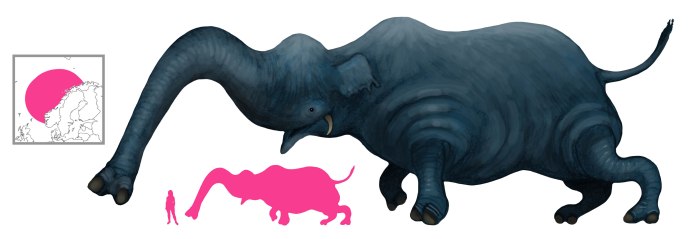Variations: Caab; Sahab (typo)

Among Aristotle’s many references to the elephant, we are told that its five toes are not perfectly jointed, its forelegs are larger than its hind ones, and its hind legs have short ankles. It has a trunk that it can use as a hand, drinking and eating with it, pulling up trees with it, and using it to breathe when walking through water. This remarkable appendage is cartilaginous and jointless.
The 1220 Latin translation of Aristotle by Michael Scot was based off an Arabic translation from the Greek. Scot retained various Arabic words in his text, and hence Aristotle’s passage on the elephant’s appendicular anatomy became et habet duo cahab parva respect magnitudinis corporis sui – here, cahab is Arabic for “ankle”, and the phrase reads “and [the elephant] has two ankles that are short relative to the size of its body”. Scot used cahab consistently to refer to the ankle or the talus bone.
Thomas de Cantimpré did not recognize the word cahab and assumed it to be the subject of the verb habet. From that the sentence became Caab animal marinum est, ut dicit Aristotiles, parvos habens pedes respectu corporis sui, quod utique magnum est, “Caab is a sea animal, as says Aristotle, whose legs are small in proportion to its body, which is huge”. Based on that and the remainder of the Aristotelian description, Thomas says that the caab has one leg that is long and which it uses as a hand to bring vegetation to its mouth; this leg is made of cartilage. Thomas also misreads the behavior of the elephant in water and makes his caab a fully aquatic marine animal, one that breathes underwater and then, upon reaching the surface, spouts the water it swallowed while breathing. Finally, he spontaneously gives his animal the feet of a cow.
In turn, Albertus Magnus “borrows” Thomas’ account, dropping the reference to Aristotle. This time it is called cahab, and now all of its legs are cartilaginous and resemble those of a calf. Albertus also makes a logical association with the cetacean act of spouting; his cahab holds its breath underwater and spouts at the surface sicut delfinus et cetus.
The last iteration of the cahab is provided by Olaus Magnus, who transposes this odd cartilage-legged sea creature into Scandinavia. He tactfully compares the cartilaginous feet to those of both cows and calves (vaccae, aut vituli). Olaus cites Albertus Magnus as the source of the cahab in the Latin version of his Historia, but the French and English translations omit this crucial citation.
Finally, the English translation misreads the name of the cahab as “sahab”, decisively casting this elephant adrift in a sea of translation errors.
References
Aristotle, Cresswell, R. trans. (1862) Aristotle’s History of Animals. Henry G. Bohn, London.
de Cantimpré, T. (1280) Liber de natura rerum. Bibliothèque municipale de Valenciennes.
Cuba, J. (1539) Le iardin de santé. Philippe le Noir, Paris.
Gauvin, B.; Jacquemard, C.; and Lucas-Avenel, M. (2013) L’auctoritas de Thomas de Cantimpré en matière ichtyologique (Vincent de Beauvais, Albert le Grand, l’Hortus sanitatis). Kentron, 29, pp. 69-108.
Magnus, A. (1920) De Animalibus Libri XXVI. Aschendorffschen Verlagbuchhandlung, Münster.
Magnus, O. (1555) Historia de gentibus septentrionalibus. Giovanni M. Viotto, Rome.
Magnus, O. (1561) Histoire des pays septentrionaus. Christophle Plantin, Antwerp.
Magnus, O. (1658) A compendious history of the Goths, Swedes, and Vandals, and other Northern nations. J. Streater, London.
Unknown. (1538) Ortus Sanitatis. Joannes de Cereto de Tridino.
What a poor f$ucked up thing.
LikeLike
Also, a elephant was the answer to the question last time?
LikeLiked by 1 person
Yup!
LikeLike
I have feelings about this creature that I can not explain.
LikeLiked by 2 people
Real Quick: Do you have bigger resolutions for your drawings?
LikeLiked by 1 person
I think the bigger resolution can be accessed by fiddling with the image’s URL 😮
LikeLiked by 1 person
Great work tracking down the history!
LikeLiked by 1 person
Can I just say that i’m so glad I can use this website and I would like to thank you for creating it? This is easily the best source for teratology i’ve ever found and it’s good to be able to talk to other people that find magical creatures just as interesting. Thank you so much.
LikeLiked by 1 person
Aaaa thank you ;~;
LikeLike
You know, considering a “Michael Scot” was mentioned in this entry, I’m surprised nobody’s referenced The Office in these comments.
LikeLike
Pingback: A Friday link: The power of (mis)translation | landofnudotcom